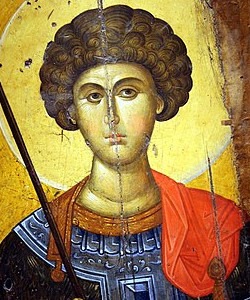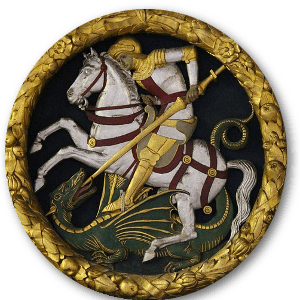
We’ve all heard of Saint George. He’s the saint who slayed the dragon, right?
But there is so much more to the man than this myth. So if you’ve always been intrigued by this icon of English heritage but never really known where to start, then this is the guide for you!
We’ll be taking you through the history of Saint George; tackling some of the most commonly asked questions and offering some exclusive insights along the way.
No previous dragon slaying experience necessary.
So let’s dive right in with a 10 step quick fire round about Saint George:
- 275 AD – Born into a Christian family
- Orphaned at age 17 and joined the Roman army
- 303AD – Refused demands from Emperor to abandon Christian faith
- 303AD – Executed by Emperor for refusing to abandon Christian faith
- 303AD – Inspired Emperor’s wife to become a Christian martyr too
- 5th Century – Made a Saint by Pope Galasius I
- 12th Century – Adopted as patron Saint of Christian soldiers
- 14th Century – Adopted as patron Saint of England by King Edward III
- Patron saint of many countries, organisations and occupations
- Saint George’s Day is celebrated on 23rd April
Now you know some basic facts about the noble knight it’s time to move on to the…
Top 8 Most Commonly Asked Questions about Saint George.
Who is Saint George?
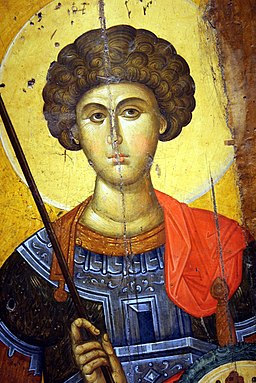
Saint George was born between the years 256 to 285 in the Cappodocia region which is now in Turkey. He was raised in the Christian faith by his Greek parents Gerontios and Polychronia.
Having lost his father at the age of fourteen and his mother a few years later, the seventeen year old George joined the Roman army. This was customary for a young Roman noble at the time.
George was a natural; quickly rising through the ranks, by his late twenties he was a distinguished Roman solider who had achieved the rank of Military Tribune. At this time George was stationed as an Imperial Guard of the Emperor Diocletian, at Nicomedia.
Christian Persecution
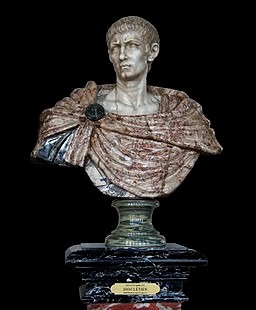 The reign of Diocletian saw the most severe persecution of Christians ever. Such was his hated for Christianity that he erected large signs informing Christians, ““You are not allowed to exist!” Destruction of churches, book burning, torture and massacre followed. Christians were to be wiped out.
The reign of Diocletian saw the most severe persecution of Christians ever. Such was his hated for Christianity that he erected large signs informing Christians, ““You are not allowed to exist!” Destruction of churches, book burning, torture and massacre followed. Christians were to be wiped out.
Everything changed for George on 24 February 303 when an edict came from Emperor Diocletian which demanded that all Christian soldiers renounce their faith and offer sacrifices to the Roman gods.
George knew that he would face certain death if he refused. However, George was resolute in his Christian faith so he freed his slaves, gave his money away to the poor and declared himself to the Emperor as a Christian who would not renounce his faith.
Initially the Emperor did his best to convert George; offering him gifts, land, money and slaves if only he would renounce his Christianity and make sacrifices to the Roman gods.
Once again George refused, so the emperor had him thrown in prison in an attempt to weaken his resolve. Whilst there, the Emperor sent a woman to visit George to spend the night with him. But that didn’t work either as George simply converted her to the Christian faith!
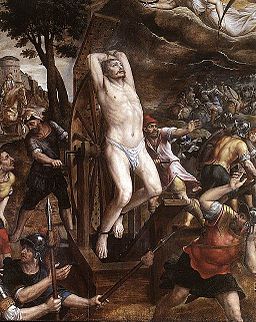 When bribery and coaxing did not work, the Emperor resorted to torture in order to force compliance.This included laceration on a wheel of swords during which he was resuscitated three times. Little did Diocletian know that nothing could induce George to renounce his Christian faith.
When bribery and coaxing did not work, the Emperor resorted to torture in order to force compliance.This included laceration on a wheel of swords during which he was resuscitated three times. Little did Diocletian know that nothing could induce George to renounce his Christian faith.
All of Diocletian’s attempts to convert the resolute soldier, failed. On the 23rd April 303 George was beheaded at Nicomedia on the orders of the Emperor Diocletian. George’s body was returned to Lydda for burial.
Lydda is a town located about 35 kilometers (22 miles) northwest of Jerusalem and 15 kilometers (9 miles) from the Mediterranean Sea. Lydda is in the coastal plain and is now called by its Arabic name, Lod.29
George’s death and devotion to his faith struck a chord among many. Not only did George convert two soldiers who were his torturers, but the Empress Alexandra of Rome was so affected by his suffering and conviction that she too became a Christian and was soon martyred for her faith.
But the legend doesn’t end here. George’s legacy as a Christian martyr was only just beginning.
↑

Why was Saint George made a saint?
After his torture and execution in 303, news of George’s martyrdom spread. Swiftly earning a reputation for virtue and holiness, George was hailed as an example of courage in defence of the poor, the helpless and the Christian faith.
People soon started to pray to George in times of need and their prayers were answered. Many times, the results of praying to George were regarded as nothing less than miraculous. The number of miracles being attributed to George quickly began to rise; so much so that the news reached the Western Roman Empire.
What was the end result?
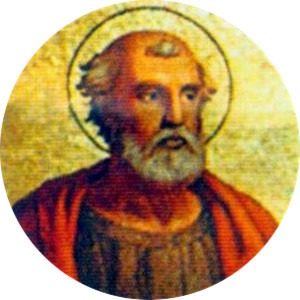
In the fifth century, Pope Gelasius I 1 canonized George (declared him a Saint), describing him as one of those “whose names are rightly reverenced among us but whose actions are known only to God.”
Far from the image of a white knight in shining armour who slays dragons and rescues damsels in distress, Saint George is a Saint because the church recognised that a number of miracles had been attributed to Saint George, following his martyrdom.
From Roman times right up to the present day, people from all different religions have been calling upon Saint George in their hour of need and claiming miracles in his name. The people learned that when you have a problem, Saint George listens and responds.
The Miracles of Saint George
Now you’re probably wondering ‘But what kinds of miracles are attributed to Saint George?’ Well, here are two testimonies of modern day Saint George miracles 2
Saint George Cured Me
“St. George [has been] my patron saint since I was young…This miracle happened to me when I was in fifth grade,
I had a Gallbladder stone, and the pain was unbearable, they tried me on several medications and nothing was helping, they put me on strict diet but it did not help… the only cure was to do the surgery.
I remember we went to St. George church in old Cairo, Egypt, where I put the chain that St. George was beaten up with on the site of the pain; and from that day on I had no pain, and I did not have to do any surgery, as if there [were] no stones.
St. George is a fast deliverer, I’ve asked for his intercession in many things and God granted it to me”.
Saint George Cured My Cancer
In September 2003, Mrs Salwa Azzouz was diagnosed with breast cancer which resulted in a radical mastectomy and half subcutaneous armpit removal.
“I was surprised, as immediately after the operation, a new type of pain, unberable bone pain, it was very severe pain, especially in the right hip joint…”
Moving became a struggle. Sleep was difficult. A whole body bone scan taken two weeks after operation revealed a very active “malignant cancerous tumour” on the joint rear of the pelvis…”
In November 2003, an MRI scan revealed there were two cancerous tumor spots. Salwa Azzouz became resigned to her fate. She accepted her sufferings, and placed her life in the hands of Jesus. She prayed for the “intercession of the Virgin Mary and Saint George the hero, and Pope Cyril the 6th…”
We’ll let Mrs Azzouz relate what happened next in her own words…
“On the eve of St. George commeration, November 16, 2003, I came to his monastery in Cairo, Egypt to take the blessings and the presence of St. George relics on the eve of his festival. I requested prayer for me and took the oil and Hnot of the great saint of St. George …
I was surprised as when I was in the monastery I felt a strange sensation in the diseased joint, and I found myself was able to walk regularly without anyone helping me as usual and the pain had been completely gone…
I went back to my house and the next day I went to the monastery again for the festival day of St. George and I’m very healthy and walking without any pain …
I was joyful and so was all the nuns in the monastary. We thanked God and the intercession of St. George and his quick response to our prayers .. Then I went back to my house and attended my daily routine…
In February 2004 I made another bone scan to ensure full recovery, and the result came out completely normal, there was no cancer spots on the hip bones and I did not have to get any treatments…
I went back to work as engineer after this miraculous recovery. I will supervised to know that my first project was a very big project for an area of 14 acres next to the monastery of St. George in ancient Egypt… Here, I realized that St. George reassures me and standing next to me …
May the intercession of St. George the Romanian hero and martyr be with all of us ….”
We could list many more accounts like this but we don’t have all day! One thing’s for sure; as Saint George’s popularity increased so did the number of countries, organisations and occupations who adopted him as their patron saint.
Patron Saint of Countries
Some of the countries who chose Saint George as their patron include: England, Georgia, Malta and Gozo, Portugal, Romania and the Aragon and Catalonia areas in Spain.

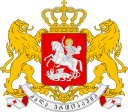
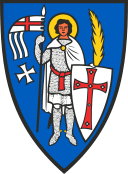

Patron Saint of Occupations
Many cultures revere Saint George. He is regarded as the patron saint of agricultural workers, archers, armourers, butchers, cavalry, chivalry, equestrians, farmers, field hands and workers, horsemen, husbandmen, knights, riders, saddle makers and soldiers.
Patron Saint of Organisations
Saint George quickly became associated with those in need, including: Lepers, sufferers of various other skin diseases, plague victims, scouts and those in prison.
 The Royal Society of St. George 3 was founded in 1894 with the noble object of promoting “Englishness” and the English way of life. Their patron is Her Majesty the Queen.
The Royal Society of St. George 3 was founded in 1894 with the noble object of promoting “Englishness” and the English way of life. Their patron is Her Majesty the Queen.“Membership of the Society is open to all people who share our love of England and Englishness.”
Patron Saint of Awards
Throughout the world a number of awards bear the image of Saint George. Inspired by his courage and religious conviction, these awards are given primarily for courage displayed by military and civilians alike.

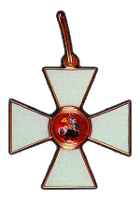
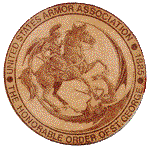
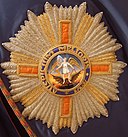
↑

When is Saint George’s day?
Short answer: 23rd April
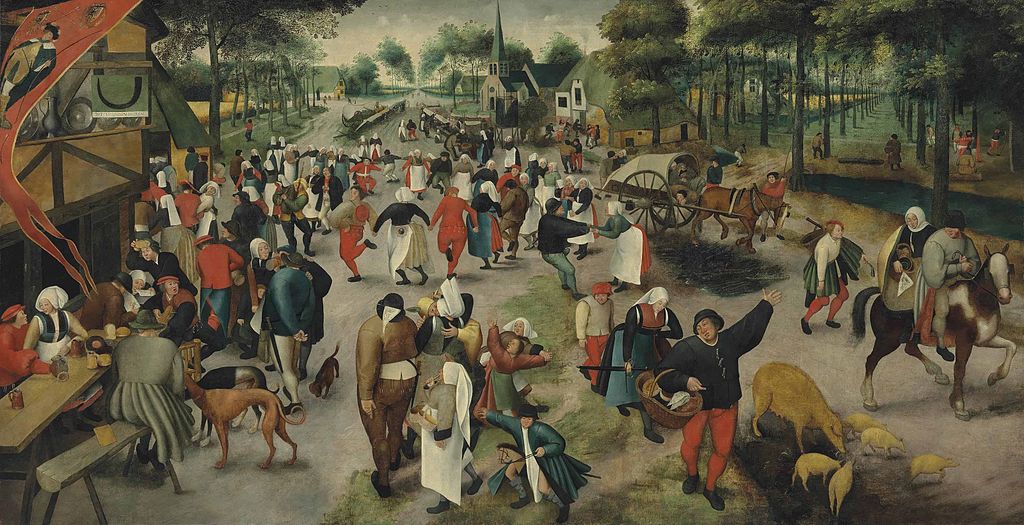
The feast day of Saint George is celebrated in different days in various different countries.
In the year 1222, the Ecclesiastical Council of Oxford officially named the feast day of Saint George to be the day he died, 23rd April. However, if Saint George’s day 4 falls between Palm Sunday and the Second Sunday of Easter then it is instead celebrated on the first Monday after Easter Monday.
The first official mention of St George’s Day in England was the listing of the Feast of Saint George on 23rd April in a calendar composed by the Venerable Bede, around 673-735. This feast day was held hundreds hundreds of years before Saint George officially became England’s patron saint.
But what do you do on Saint George’s day?
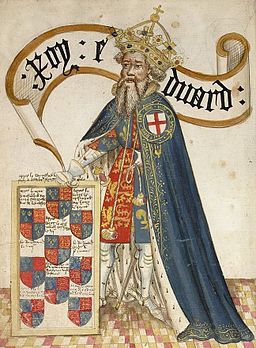 King Edward III
King Edward III
Well, in 1348 King Edward III created the Order of the Garter, a chivalrous organisation with 26 founder members 5. This order was intended to be reserved as the highest reward 6 for loyalty and military merit and dedicated to the honour of Saint George who is their patron.
On each Saint George’s day the Knights would meet at the chapel at Windsor 7 for celebrations which would start with Holy Mass, followed by a tournament 8 and feast in Saint George’s honour.
King Edward III made sure the celebrations were a lavish affair, with no expense spared. The Order of the Garter is a tradition that is still upheld. The reigning monarch holds the position Sovereign of the Garter.18
King Henry V
Following King Henry V’s triumphant victory at the battle of Agincourt (1415), Saint George’s Day became one of the most celebrated feast days in the English calendar. It was elevated to a “double major feast day 9” in the declarations of the Province of Canterbury in 1415 and the Province of York in 1421.
The Pope
In 1969, Pope Paul VI demoted Saint George’s day to ‘optional worship’, due to the absence of definitive documentary proof about Saint George. Though still a Saint, his feast day was removed from the Universal Calendar.
 However, due to popular demand Pope John Paul II reinstated Saint George’s feast day back into the church calendar in 2000.
However, due to popular demand Pope John Paul II reinstated Saint George’s feast day back into the church calendar in 2000.
London Mayor Boris Johnson
In March 2009, Mayor Boris Johnson, mindful of the power of tradition, called for a more enthusiastic celebration of Saint George’s Day 10 in London.
↑

Did Saint George really slay a dragon?
It’s the question everybody asks and for good reason! The tale of Saint George and the Dragon truly is a legend.
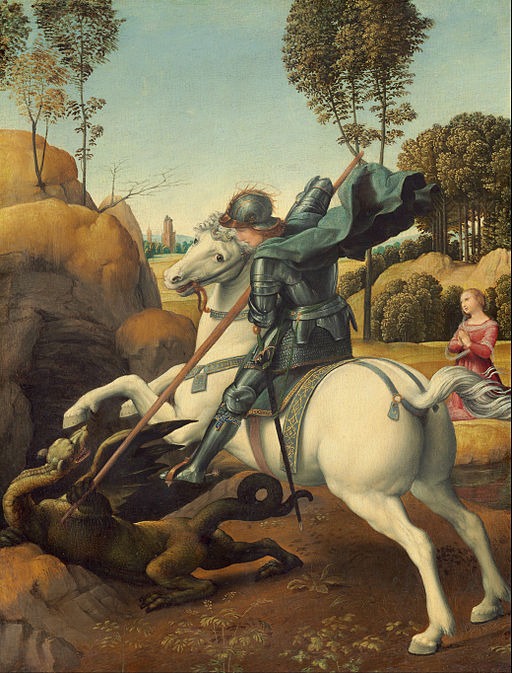
To answer this question, we’ll have to take you back to 1260 when Jacobus de Voragine, a scholarly friar who later became Archbishop of Genoa, recorded the tale of Saint George and the Dragon in a compilation of stories about the saints entitled The Golden Legend.
Here is a summary of the story as related by Jacobus de Voragine:
Saint George and the Dragon
The story centres around a “dragon” type beast who lives in the watering hole of a nearby village. The dragon is terrorizing the locals who are too scared to collect the water they need.
As with pagan tradition, the locals offer a lamb or goat as a sacrifice every week to appease the beast to leave them alone.
With the livestock dwindling, the sacrifices offered soon become the children of the village. A weekly lottery is held to select the next victim and eventually the King’s daughter’s name is drawn.
At a distance outside the village walls, while the princess is waiting for the dragon to arrive, George passes by and observes her distress.
When he hears the tale of the dragon, he determines to kill the beast: “fair daughter, doubt not, for I shall help you in the name of Jesus Christ”.
The princess implores him to leave as he is in danger but George is resolute. Suddenly, the dragon appears and charges towards them. Still on horseback, Saint George draws his sword, makes the sign of the cross and rides swiftly towards the dragon.
With the mortally wounded dragon on a leash, George and the princess return to the village. George offers to kill the beast for the villagers, but in return they must consent to convert to Christianity. Over 15,000 men were baptized as a result.
The king wanted to reward George with vast sums of money but George refused, asking instead that it be given to poor people for God’s sake.
So “the king established a church in honour of Our Lady and of Saint George in which there flows to this day a fountain of living water that heals sick people who drink from it”.
Some believe this tale has a foundation in truth but that the beast was not a dragon. Instead, they say that George fought a very large crocodile and that the incident took place in Beirut. The pagans were inclined to label anything threatening as a “dragon” and also had a custom for appeasing that which they feared, with sacrifices.
Others believe that this story is symbolic of Saint George’s life: slaying the dragon represents his martyrdom and saving all the villagers’ lives represents the many conversions to Christianity he inspired.
Whether you believe the story is symbolic of his life or that it is an historical account of a real event, the tale clearly illustrates the character and the religious conviction of Saint George:
- A man with unshakeable faith in Jesus Christ.
- A man who showed immense courage in battle.
- A man who constantly risked his life for others.
- A man who came to the aid of those who could not defend themselves.
Killing a dragon was just a bonus!
↑
Why is Saint George the patron saint of England?
Short answer: Edward III nominated Saint George as the Patron Saint of England in 1350.
News of Saint George had reached England from as early as 670. However, it was from 1099 onwards that Saint George truly started to resonate with the people of England which influenced monarchs to adopt him as their protector and patron saint.
| Year | Honour | Founder |
|---|---|---|
| 1099 | During the Crusades, Saint George was first adopted as patron saint of soldiers 11 | Robert II Duke of Normandy (1087-1106), son of William the Conqueror |
| 1348 | Named Patron 12 of the Order of the Garter | Edward III |
| 1350 | Named Patron Saint of England 12 | Edward III |
| 1415 | Feast of Saint George, 23rd April, is elevated to double major feast day 14 | Henry V |
| 1552 | Established as primary patron saint of England 15. All saints’ flags and religious banners except for Saint George’s are abolished. | The Reformation |
The Crusades
During the Crusades, Saint George was a shining example and inspiration to the soldiers. As a distinguished soldier with the Roman army, Saint George would have understood their plight. With a reputation for bravery and Christian devotion, Saint George gave strength and courage to Christian soldiers who were far from home and suffering from heat exhaustion and lack of food and water.
At the sieges of Antioch and Jerusalem, there were many men who claimed to have seen a vision of Saint George on the battlefield, fighting alongside them and encouraging them.
Peter Tudebode, a Poitevin priest who attended the first Crusade, gives an account of the apparition of Saint George at the Siege of Antioch.19
On returning to England, soldiers would bring back stories about Saint George and the miracles performed in his name. Saint George earned a reputation as a Saint who listened and responded to those in need.
Edward III
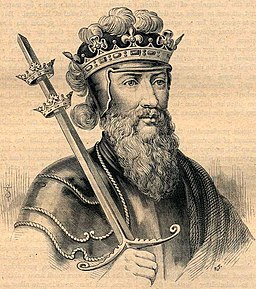 King Edward III was devoted to Saint George, as was his father. In fact, Edward owned several relics of the Saint.
King Edward III was devoted to Saint George, as was his father. In fact, Edward owned several relics of the Saint.
Edward III’s reign brought much social and economic change in England but above all he was known as a great military leader.
Inheriting the throne of England at the tender age of 14, Edward III went on to revolutionise how battles were fought. Up until his reign, most battles took place at close quarters, slugging it out with short range weapons or hand-to-hand combat. Edward encouraged the development of cannons 17 and the use of rapid-shooting longbows.
Under Edward’s guidance, English armies could quell attacking forces from a distance. These strategies reduced his own men’s casualties and made them practically invincible against the contemporary armies of the day.
Edward evoked Saint George’s name in his war-cries, marched under banners dedicated to Saint George and prayed to the Saint for courage and guidance. Edward’s combination of advanced military strategies with a devoted, faith-driven army and country all helped to make England the most powerful nation in Europe by the late 1340s.
To honour Saint George, in 1348 Edward III created the Order of the Garter 18, which is hailed as the most prestigious order of chivalry.
Many of the traditions of the Order of the Garter that were established by King Edward III are still celebrated today. New members are personally appointed by the Sovereign of the Garter (The Queen) and announced on Saint George’s day. The investitures and celebrations take place on Garter Day, each June.
During Edward III’s reign, the flag of Saint George blustered boldly in the breeze above Windsor Castle. Edward and the people felt a strong banner of protection under Saint George.
Henry V.
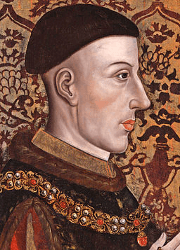 Following on from Edward III, Henry V (1387-1422) also increased the profile of Saint George as the patron Saint of England.
Following on from Edward III, Henry V (1387-1422) also increased the profile of Saint George as the patron Saint of England.
The Battle of Agincourt (1415) was expected to devastate Henry V and his English army. However, Henry prayed to Saint George for courage and fortitude and the people in England were asked to pray to Saint George for the king’s safety.
It worked!
On Henry V’s triumphant return to England, the statue of Saint George occupied a significant part of his procession through London. This procession had been prepared with typical theatrical appeal (even following the same route that had been taken by The Black Prince in 1357).
As victory laps go, it was impressive; calling at Canterbury, Eltham Palace and eventually onto the streets of London where the purple clad King Henry V received an incredibly warm welcome from the crowd!
Following the success at Agincourt, Saint George’s Day was elevated to a double major feast day.
Shakespeare
 As well as sharing his birthday with the feast of Saint George, the bard clearly revered the Saint. After all, he mentioned him no less than 18 times in his plays!
As well as sharing his birthday with the feast of Saint George, the bard clearly revered the Saint. After all, he mentioned him no less than 18 times in his plays!
Immediately before the battle of Agincourt, Henry V addressed his heavily outnumbered troops with a speech to evoke English pride, courage and determination.
In his play, Henry V, William Shakespeare captured the spirit of that address in a powerfully motivational speech which culminated in the famous battle cry:
Follow your spirit, and upon this charge Cry ‘God for Harry, England and Saint George!
As well as sharing his birthday with Saint George’s Day, William Shakespeare ‘shuffled off this mortal coil’, on the same date, 23rd April. Spooky, eh?
Reformation & Patron Saint of England
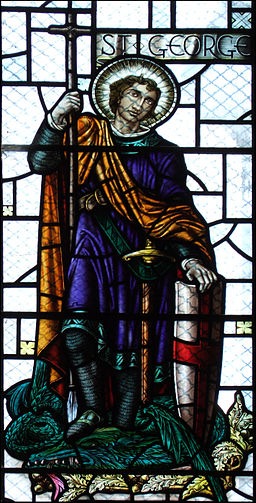 Despite the dedication to Saint George across England, he still had two rivals for the patronage of England – Saint Edward and Saint Edmund. Many were still faithful to these saints.
Despite the dedication to Saint George across England, he still had two rivals for the patronage of England – Saint Edward and Saint Edmund. Many were still faithful to these saints.
However, the English Reformation changed all that. Saint George finally rose to the position of the primary patron Saint of England during this time with the revised prayer book of 1552.19
At this point, all other religious flags and saints’ banners were abolished leaving only Saint George to become the true recognised Patron Saint of England.
George had become the saint to whom kings and armies prayed during battle but he also represented “good politics”. Under his protection and guidance, England prospered, and people continued to celebrate Saint George’s day enthusiastically.
↑
Did Saint George ever visit England?
Saint George was born in Cappodocia (which is now in Turkey), joined the Roman Army at the age of 17 and died in the year 303 at Nicomedia. Some believe he travelled to England as a soldier with the Roman Army under the command of the Emperor Constantine. There are also some references to him visiting Glastonbury. Neither of these claims can be substantiated.
Typically, a saint is not chosen as patron for the country in which he was born. For example, Saint Andrew of Scotland was born in Israel, whilst Saint Patrick of Ireland was born in Roman Britain.
It is unlikely that George ever made the journey to dear old Blighty during his lifetime.
Saint George’s Relics
Saint George’s physical presence in England was known to exist after his death in the form of relics 20 i.e. ‘the physical remains of a saint or the personal effects of the saint or venerated person preserved for purposes of veneration as a tangible memorial’
Edward III, the King who established Saint George as patron saint of England, was known to have a number of precious relics in his possession, including relics of Saint George, which he placed in the Chapel at Windsor soon after founding the Order of the Garter.
Indeed, “early inventories of the College of St George 21 show that in the Middle Ages the Chapel was home to a spectacular array of relics which drew pilgrims to Windsor“ which included “two fingers, part of the heart and part of the skull of St George.”
Sadly, after the Reformation, the veneration of relics was rejected because it was considered to be a Roman Catholic practice. As a result, the location of these specific relics is currently unknown.
Where are Saint George Relics Today?
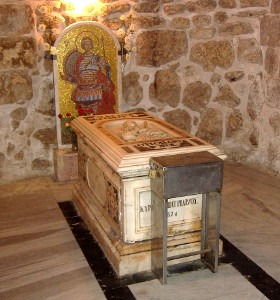 Some relics of Saint George reside in his tomb which is situated in The Church of Saint George in Lod, Israel 22. There are also some relics in a silver display case in the main body of the church.
Some relics of Saint George reside in his tomb which is situated in The Church of Saint George in Lod, Israel 22. There are also some relics in a silver display case in the main body of the church.
A confirmed relic of Saint George resides in the Treasury of Saint Mark’s Basilica 23 in Venice.
In 2014 this relic was taken on a visit to Malta and Gozo following a request made by Bishop Mario Grech.
(George is one of the patron saints of Malta and Gozo)
In November 2016 the relic of the right hand of Saint George was brought to The Twelve Apostles Greek Orthodox Church in Hertfordshire, England 24 from the Xenofontos Monastery for the faithful to receive the blessings of Saint George.
The presence of Saint George in England has never been a prerequisite of his patronage. Over several centuries, the people of England developed a great affection and loyalty towards Saint George. When they faced adversity and prayed to Saint George, they strongly believed their prayers were answered.
Dating back to the 11th century, England prospered and the people felt protected under the patronage of Saint George.
↑
How did Saint George get his own flag?
It all started with the flag of Genoa

From at least the 12th century onwards, the flag of Genoa 25 was a red cross on a white background. Initially, the locals maintained a separate flag for Saint George: a red flag depicting Saint George fighting a dragon.
But why is the flag of Genoa important?
Well, the Genoese played a vital part in the Crusades. At First their intention may have been a business involvement 26, with merchant ships supplying food and materials to the visiting Christian troops. However, they also participated in sieges and conquests including Antioch (1098) and Jerusalem (1099).
This Genoese assistance did not go unrewarded. After all, their actions also secured concessions for future trade centers of potential economic interest, such as Antioch.
During the siege of Jerusalem (1099), the crusading troops were facing hardship following their long march from Antioch. Much of the water and food they would have collected along the way had been sabotaged by the enemy and their supplies were dwindling daily.
The arrival of several Genoese galleys must have been a most welcome relief! These galleys brought building materials and skilled workers which were pivotal in the battle for Jerusalem.
During this time the red cross on a white background became the standard banner for the Christian crusaders and it was known as the flag of Saint George. The flag flown by Genoa is therefore identical to that adopted by England- a red cross on a white field.
Crusaders returning to England would have brought stories of the brave martyr Saint George and his flag would have become more recognised.
In fact, it is thought that this flag with a red cross on a white field was adopted by England and the City of London 27 as early as 1190. Doing so meant that ships entering the Mediterranean would be assured of the protection of the most powerful Genoese fleet.
Famously recorded Saint George Flag Moments
There are many momentous occasions recorded in history that have been marked under the banner of Saint George.

The Cross of Saint George was flown in 1497 by John Cabot on his voyage to discover Newfoundland.

Sir Francis Drake and Sir Walter Raleigh also proudly flew the flag of Saint George.

In 1620, the Saint George Cross was even flown on the foremast of the Mayflower when the Pilgrim Fathers arrived in Plymouth, Massachusetts.

The Saint George’s cross re-emerged at the 1998 World Cup when both England and Scotland were competing. Fans of England liked the tradition so much they have been flying it ever since at football matches around the world to represent the England team!
↑
Should England celebrate Saint George’s day?
Short answer – Yes
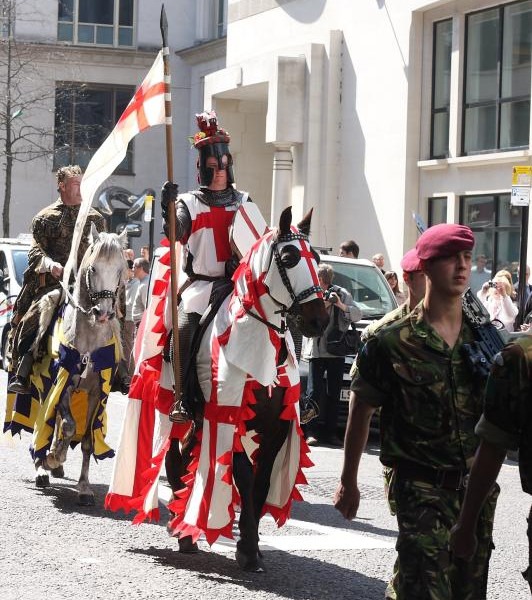
2010 saw the first St George’s Day Pageant in the City of London for 425 years
The feast day of Saint George is celebrated on 23rd April. This is the anniversary of the date Saint George was executed following months of imprisonment and torture because he refused to renounce his Christian faith and worship Roman gods.
Sadly, time has reduced the legend of Saint George to a fairy-tale story about a knight slaying a dragon and rescuing a princess. The reality of Saint George’s legacy is so much more.
In medieval times, Kings of England prayed to Saint George for courage and guidance when they were up against seemingly impossible odds. Faith in Saint George prompted the grateful Kings to honour their patron with lavish feast days, celebrations and orders of chivalry to be commemorated on his day.
Their intentions were for those traditions to be upheld, that future generations of England would give thanks to the Saint who had helped guide and protect them through difficult times.
Saint George is still there for the faithful, for those who acknowledge he has been there for them in their hour of need and will continue to be there for those in need today.
Those who celebrate Saint George’s Day and remember his miracles span all manner of nationalities, religions and centuries.
Whether you believe in miracles, religious faith, or simply the power of the human spirit, Saint George has always been there in England’s time of need to instil hope, courage, comradery and the promise of a brighter day.
We would say that deserves celebrating, wouldn’t you?
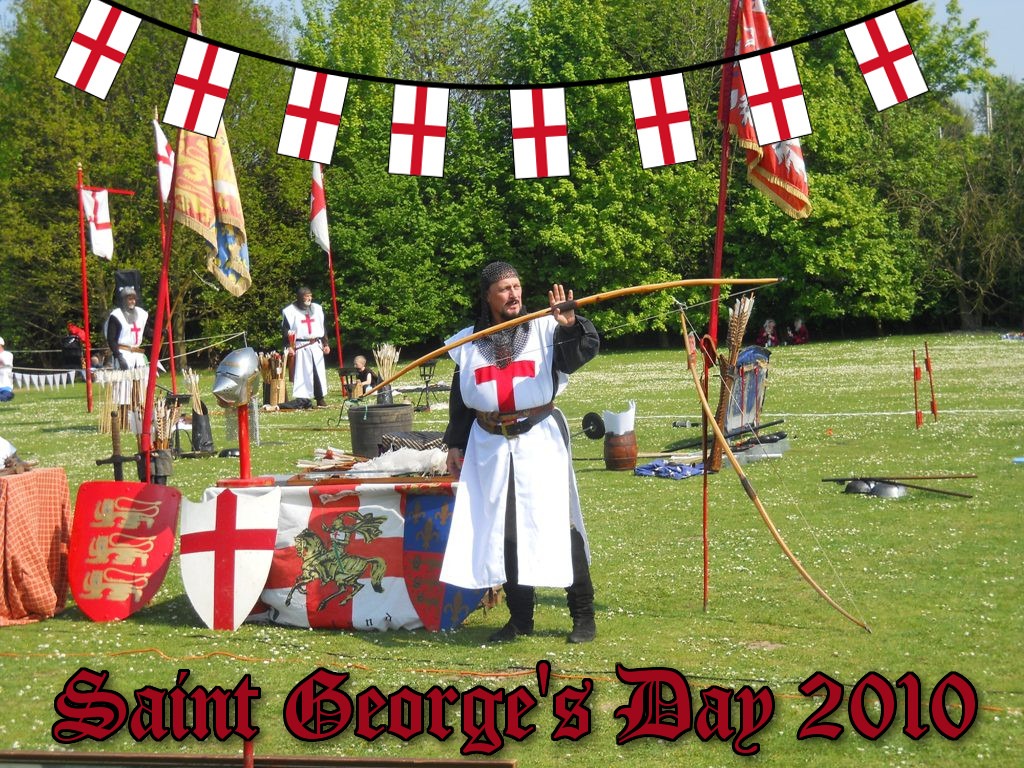
↑

Footnotes:
1. Pope Galasius
2. Saint George miracle
3. Royal Society of St. George
4. Saint George’s day
5. 26 founder members.
6. highest reward
7. chapel at Windsor
8. tournament
9. “double major feast day”
10. Saint George’s Day
11. patron saint of soldiers
12. Patron
13. Named Patron Saint of England
14. double major feast day
15. primary patron saint of England.
16. Siege of Antioch:
17. development of cannons
18.Order of the Garter,
19. revised prayer book of 1552.
20. relics
21. College of St George
22. The Church of Saint George in Lod, Israel
23. Treasury of Saint Mark’s Basilica
24. The Twelve Apostles Greek Orthodox Church in Hertfordshire, England
25. flag of Genoa
26. business involvement,
27. City of London
28. Mayflower
29. Location of Lydda

